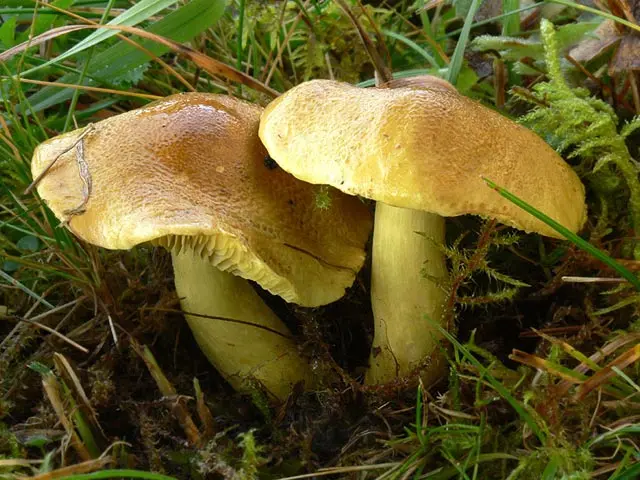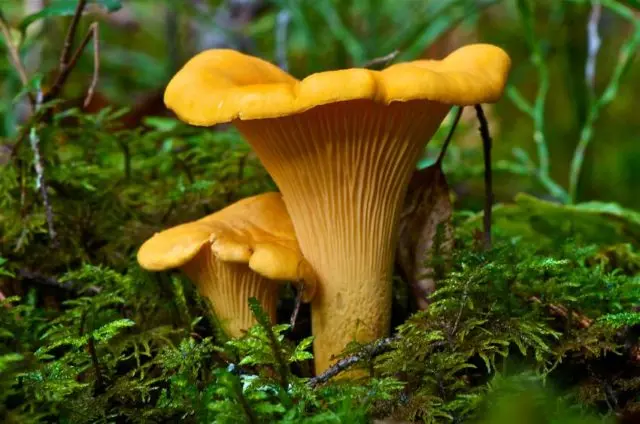Contents
There is no mushroom picker who would not like to pick up a whole basket of good-quality porcini mushrooms. Without knowing the exact proven places of their growth, you can focus on his preferences and fruiting period. White mushrooms grow in a variety of places.
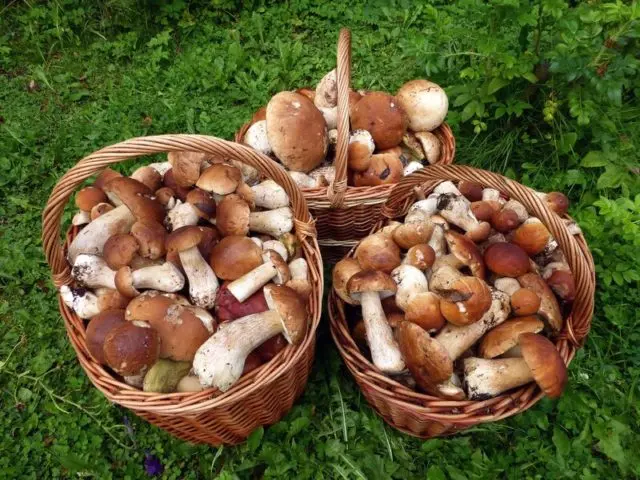
Where do white mushrooms grow
If you go into science, then the white mushroom is not one species, there are about 18 varieties, and everyone has different preferences. Each creates a symbiosis (mycorrhiza) with specific types of trees, and of a strictly defined age. However, the discovery of a symbiont tree does not mean at all that a boletus lurked under it. The composition of the soil, the level of humidity and the ambient temperature are also important.
As befits noble representatives, mushrooms are very picky about the conditions and do not grow anywhere. That is why avid mushroom pickers, who know the area well, are in no hurry to share their mushroom places, where porcini mushrooms bear fruit abundantly and annually.
What forests grow porcini mushrooms
The temperate zone of the Northern Hemisphere is dominated by coniferous forests. This is the most characteristic landscape for mushrooms. The pine white fungus (Boletus pinophilus) usually settles in pine forests. It is distinguished by a red-brown or chocolate hat and a thick puffy leg with a characteristic brownish mesh pattern. The fungus loves sandy soils and loams, never settles in lowlands and swamps. In mountainous areas, prefers higher places.
Typical habitats:
- sphagnum or lichen glades;
- edges of clearings and glades;
- edges of forest roads.
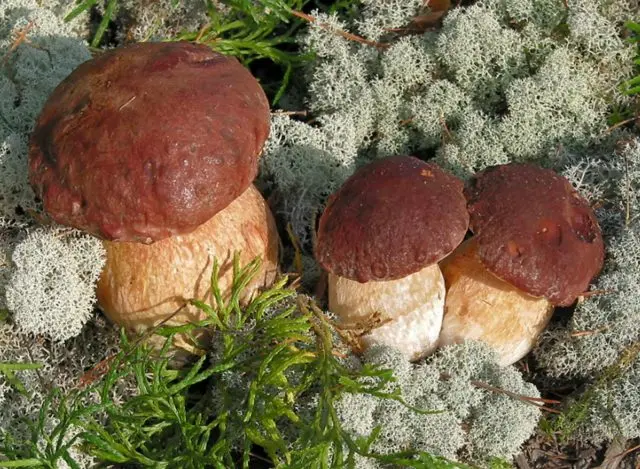
In spruce forests, you can find a similar species – spruce white fungus (Boletus edulis). It is a typical representative of the genus and is often referred to as common. The color of the cap varies from light to dark brown. Its growth conditions are identical to the previous species: well-lit dry areas with thick litter of lichens and mosses are favorite places. Spruce boletus also grows in old fir and spruce-fir forests.
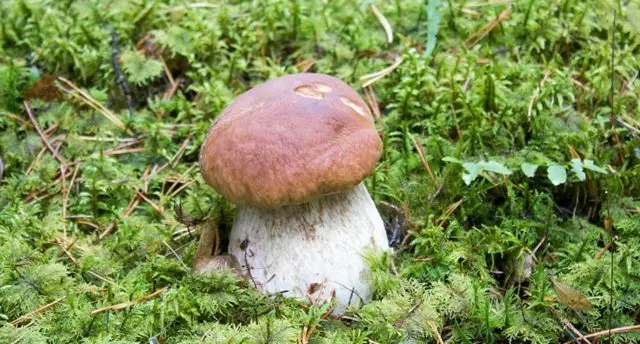
White mushrooms also grow in deciduous forests, which also occupy a considerable area, especially in the southern regions. The most unpretentious and common is the birch white fungus (Boletus betulicola), which is popularly called the spikelet. The first mushrooms appear in the forest when rye begins to ear. They can be found in almost any birch forest, especially along the edge of open areas and on the edges.
To increase the likelihood of finding a spikelet, you need to know two signs:
- White mushrooms grow in a birch forest, where there are tussocks of white beetle grass.
- Mushrooms-neighbors of birch boletus are chanterelles and red fly agaric.
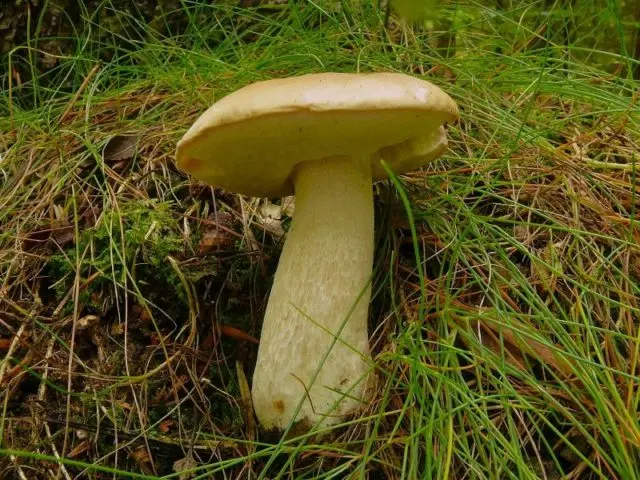
In oak forests, porcini mushrooms are harvested, called bronze boletus (Boletus aereus). They have a dark, in some cases almost black, cap with a whitish coating resembling mold. Mushrooms grow in warm climates and are rare in mountainous areas. The most widely used in the south-west of Europe, as well as in North America.

Many mycologists note the largest concentration of porcini mushrooms in mixed forests. This is due to the presence of several symbionts at once, which allows different species to grow in the same territory. The undergrowth plays an important role. The massive growth of mushrooms is associated with the presence of birch, because the variety that creates mycorrhiza with it is the most common of all.
Where do white mushrooms grow in Our Country
The area of growth of the white fungus on the world map covers all continents, excluding Australia and the polar regions of Antarctica. In Our Country, it is distributed from the Murmansk region to the Caucasus Mountains, from the western borders to the Chukotka Peninsula. However, boletus does not grow everywhere. For example, it is extremely rare in the tundra and forest-tundra, but it bears fruit abundantly in the northern taiga. From the western regions to Eastern Siberia, the population of porcini mushrooms is gradually decreasing; mushrooms are not uncommon in the Far East. In forest-steppe conditions, they are found infrequently; they do not grow in the steppe zone.
Under what trees do porcini mushrooms grow
Mushrooms create mycorrhiza with trees such as:
- spruce;
- Pine;
- fir;
- oak;
- Birch.
Some experts argue about the growth of porcini mushrooms in elm and elm forests. There are known cases of birch, pine and spruce species being found there. But many mycologists talk about the difficulties of forming a symbiotic relationship with elm due to the specifics of the biological processes in the tree.
Speaking about the preferences of mushrooms, one cannot but take into account the age of the forest. The older and more virgin the area, the more likely they are to be found. They grow under trees 20-50 years old and older, because the formation and development of mycelium in these representatives of the genus Boletus takes more than a dozen years.
Where do white mushrooms grow
In flat areas, mushrooms are more common than in mountainous areas. They prefer well-drained, not waterlogged soils:
- sandstones;
- soups;
- loam
In peatlands and swampy areas, boletus mushrooms practically do not grow. They love lighted areas where trees are rarely located, but it happens that they bear fruit abundantly in the shade under the dense crowns of conifers. Interestingly, in the harvest year, illumination does not play a significant role, but in rainy and cold summers, boletus mushrooms appear only at the borders of the forest, where it is drier and the soil warms up better. In hot weather, fruiting bodies grow in the grass under shrubs, in the shade of trees. You need to look for porcini mushrooms in the forest in places where there is a litter of moss (cuckoo flax, sphagnum, reindeer moss) and lichens.
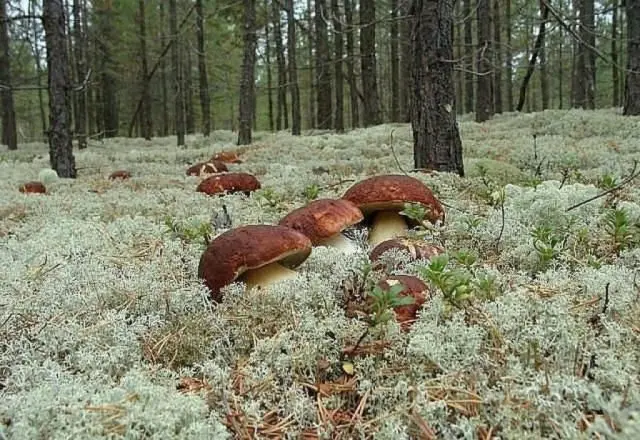
When to pick porcini mushrooms
The fruiting time of mushrooms depends on the climate. In the conditions of the northern temperate zone, porcini mushrooms are harvested from mid-June to the end of September. There are cases when they were found at the end of spring, but this is rather an exception to the rule. In warm regions, the collection of porcini mushroom stretches until October.
In what month is the porcini mushroom harvested
The most massive growth is observed in the second half of August. Mushrooms grow singly and in groups, sometimes forming circles, popularly called “witch rings”.
At what temperature do porcini mushrooms grow
The optimal temperature for the development and growth of the fruiting body:
- in July-August – 15-18°C;
- in September – 8-10°C.
With an increase in temperature to 20 ° C, the growth of the mycelium and the formation of fruiting bodies slows down. Sudden changes in temperature at night and excessive humidity do not benefit the boletus. The most favorable weather conditions for it are moderately warm weather with short-term thunderstorms and night fogs.
Peculiar indicators of the appearance of this representative are other species:
- spruce and pine boletus appears simultaneously with greenfinch (Tricholoma equestre);

- the birch form begins to grow with the appearance of common chanterelles (Cantharellus cibarius);

- it makes sense to look in oak forests when the first green russula (Russula aeruginea) come out.

How much white mushroom grows
The growth rate of porcini mushrooms directly depends on weather conditions. Humidity should be within 60%. If, after prolonged inclement weather, drought comes abruptly, the species stops growing, even if the soil is sufficiently well moistened. At low humidity, the fruiting body dries quickly, because it is not protected from evaporation.
Most intensively porcini mushrooms grow after rain. This is especially noticeable in young specimens in the first three hours after heavy but short-term precipitation. Already on the 4-5th day, the weight of the fruiting body can reach 180 g. On average, it takes a week for a boletus to reach an adult state.
Growth is also affected by pest larvae. If they crawl up from the bottom of the stem, development does not stop; if the cap is damaged, the boletus stops growing. According to the observations of mycologists, a fungus growing nearby, not affected by insects, begins to develop much faster than its diseased counterpart. In some cases, egg laying is destroyed by squirrels or slugs, then the fetus can grow to a very impressive size.
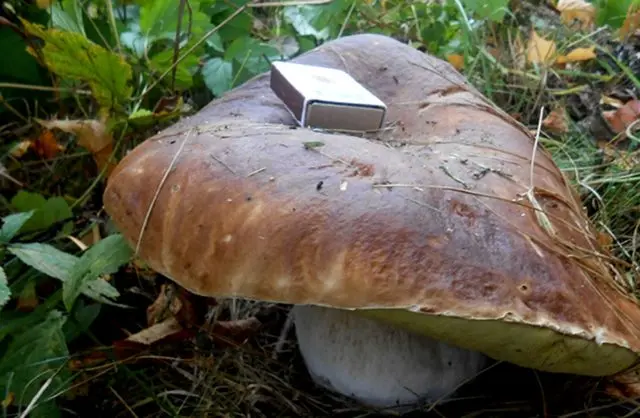
The life of the white fungus is short – only 12-14 days. At first, the leg stops growing, after 2-3 days the hat. Rapid aging begins as soon as the spores mature.
How to find white mushroom in the forest
Summarizing the above, we can reduce the nuances of the growth of whites to the following points:
- Birch, fir-trees, pines, firs, oaks should grow in the forest.
- The age of the trees is at least 20-50 years.
- The area is quite dry, not swampy.
- The soil is loamy, sandy or sandy.
- The forest floor is represented by mosses and lichens, there are grass tussocks.
- Ceps are photophilous, grow along the edges and in light forests, preferring hills.
How to pick porcini mushrooms
Collection is safe only in environmentally friendly places, away from the roadway and industrial facilities. It is better to leave suspicious specimens in the forest, because one single fruit can cause poisoning or damage to the entire batch of blanks.
Fruit bodies are carefully cut with a knife at the base, inspected for worminess and put in baskets. You can also collect in plastic bags, white ones do not crumple as much as russula.
The fact that the fruits cannot be uprooted or twisted, most mushroom pickers have heard since childhood. According to many, such an attitude towards forest gifts can damage the mycelium. In fact, the fruiting body is nothing more than a kind of “stand” for the maturation of spores, the main part is underground. When a small number of mycelial threads break in the place where the fruiting body was plucked, the mycelium does not particularly suffer. The threads number in the billions, and the wounds heal quickly.

Conclusion
Having learned when and where porcini mushrooms grow, you can safely gather in the forest. Given all the nuances and preferences of these capricious forest dwellers, there is no doubt that the basket will not remain empty. And even if the harvest is modest, a walk through the forest is a pleasure in itself.










